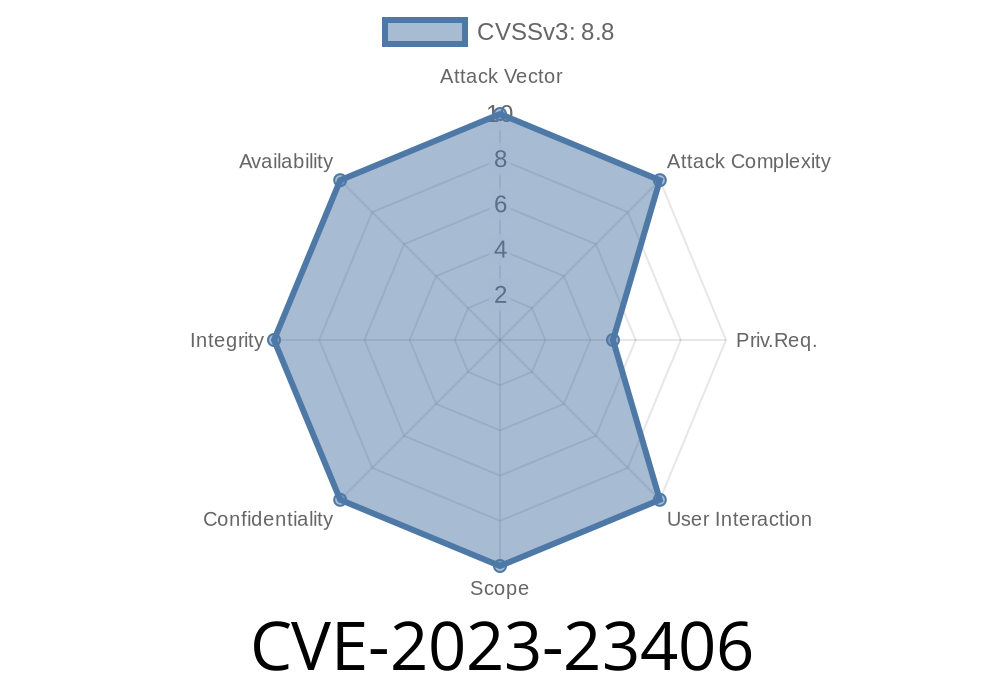Greetings, fellow cybersecurity enthusiasts! Today, we'll dig deep into a recent vulnerability identified in Microsoft's PostScript and PCL6 Class Printer Drivers. Tagged as CVE-2023-23406, this security flaw has caught the eye of many security researchers and IT admins. The vulnerability allows an attacker to execute arbitrary code on a victim's system, making it a significant concern for organizations relying on these drivers. In this post, we'll discuss the vulnerability in detail, including its background, technical analysis, exploit details, and links to original references. So, buckle up for an exclusive inside look at CVE-2023-23406!
Background
Before we dive into the specifics of the vulnerability, let's first understand the environment in which it exists. Printer drivers, such as Microsoft's PostScript and PCL6 Class Printer Drivers, enable communication and functionality between the printer and the computer system. In this case, the affected drivers are responsible for converting print jobs into a format that the printer can understand.
The Vulnerability
CVE-2023-23406 is a remote code execution (RCE) vulnerability that exists in Microsoft PostScript and PCL6 Class Printer Drivers. This security flaw can be exploited by a malicious actor to execute arbitrary code on the victim's computer with the same privileges as the logged-in user. The vulnerability lies in the mishandling of certain input patterns by the drivers. An attacker can exploit this vulnerability by crafting a malformed print job, which contains malicious code designed to exploit the vulnerable drivers.
Technical Analysis
The vulnerability resides in a specific function that handles printer data within the drivers. The function takes user input, such as a print job, and processes it to create a new data structure before passing it on to the printing mechanism. However, due to improper validation of the user input, an attacker can craft a specially designed print job containing specific patterns of data to trigger the vulnerability.
Here's a code snippet that demonstrates the vulnerable function in action
void vulnerable_function(char *input_data, size_t input_length) {
char buffer[256]; // Fixed-size buffer for processing input data
// Processing input data without proper validation
for (size_t i = ; i < input_length; ++i) {
buffer[i] = input_data[i];
}
}
As seen in the code snippet above, the function processes the input data without proper validation. This allows an attacker to create a specially crafted print job that exploits the vulnerability by overwriting the fixed-size buffer with arbitrary code. Once the code is executed, it gives the attacker full control over the target system.
To exploit the vulnerability, an attacker would typically follow these steps
1. Craft a specially designed print job containing the malicious payload that exploits the vulnerable drivers.
Wait for the victim to print the job, or trigger the print through social engineering tactics.
4. The malicious code will execute within the driver's process, providing the attacker with control over the target system.
Remediation
Microsoft has been informed about the vulnerability and has released a security update to address the issue. It is crucial for users and organizations using the affected drivers to apply the necessary patches immediately to mitigate the risk posed by CVE-2023-23406.
For more information on CVE-2023-23406, check out the following resources
1. CVE-2023-23406 - National Vulnerability Database (NVD): https://nvd.nist.gov/vuln/detail/CVE-2023-23406
2. Microsoft Security Update Guide: https://portal.msrc.microsoft.com/en-us/security-guidance
Conclusion
CVE-2023-23406 serves as a critical reminder of the importance of regularly updating software and keeping abreast of the latest security updates. By staying informed and diligently applying patches, organizations can better protect themselves from potential exploits targeting vulnerabilities in their systems. If you found this post valuable, stay tuned for more insights into the world of cybersecurity!
Timeline
Published on: 03/14/2023 17:15:00 UTC
Last modified on: 03/23/2023 16:54:00 UTC
